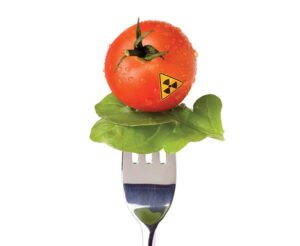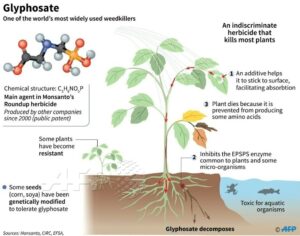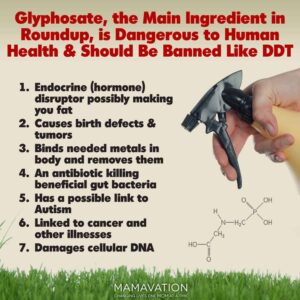Gut-Wrenching Dangers of ROUNDUP


Glyphosate is the active ingredient in the pervasive herbicide and pesticide Roundup®. The same Roundup used as to control dandelions in your yard and weeds growing in the cracks of your walkways is sprayed on your food and you consume it on a regular basis. Monsanto, Roundup’s manufacturer, convinced the U.S. regulatory agencies over four decades ago that glyphosate is practically nontoxic to humans.
A study published in the journal Environmental Sciences Europe reveals that Americans have applied 1.8 million tons of Roundup since its introduction in 1974. It’s enough to spray nearly half a pound of Roundup on every cultivated acre of land in the world. This is a staggering amount, says Charles Benbrook, study author.
The sheer quantity of herbicide applied on our planet makes its contamination inescapable! It is in our soil, our water, 75% of the rain samples in the Midwest tested positive for it, it contaminates least 75% of the foods in our grocery stores (probably more). Its found in umbilical cord blood, breast milk, and all the childhood vaccines. <Glyphosate testing results Moms Across America>
.png)
No Protection from Regulatory Agencies
Glyphosate formulations are often claimed to be safe by industry-linked sources.However, these claims are based on outdated and largely unpublished studies on the isolated ingredient glyphosate, commissioned by manufacturers in support of their application for regulatory authorization. In 2013, Monsanto requested and received approval from the U.S. Environmental Protection Agency for increased tolerance levels for glyphosate. <6> Recent court findings show that the corporation Monsanto ghost wrote research, bought off and lied to regulatory agencies to increase the usage (and profits) of their product. <Monsanto Confidential Internal Documentation> And because of its perceived nontoxicity, the government has put minimal effort into testing residue levels in the foods that we put on our table. The crops that are engineered to resist glyphosate are highly contaminated because they take up the glyphosate and incorporate it into their tissues. <1>

Systemic pesticides are chemicals that are actually absorbed by a plant when applied to seeds, soil, or leaves. The chemicals then circulate through the plant’s tissues, killing the insects that feed on them. Use of these pesticides on food crops began in 1998, and has steadily increased. Unlike with traditional insecticides, you can’t wash or peel off systemic pesticide residues.
– Mother Earth News
You can’t wash or cook off the glyphosate residue. Contaminated crops include corn, soy, canola, alfalfa, and sugar beets. As well, many grains, legumes, and other crops are sprayed with glyphosate right before harvest as a desiccant or ripener. These include sugar cane, wheat, barley, and oats, among others. Even non-GMO crops use glyphosate just before harvest. While the FDA has a regulated ‘safe level’ limit on glyphosate contamination, they fail to take into account that it bioaccumulates in our bodies.
Miniscule amounts of RoundUp in the parts per trillion are shown to increase the growth of breast cancer cells. Regardless of FDA limits, the reality is that there is no safe level of glyphosate consumption.
One study out of Norway looking at Roundup Ready soybean crops confirmed the presence of glyphosate inside the beans themselves, and even Monsanto itself admits that some glyphosate remains on and in food crops like canola, cotton, and corn that are heavily sprayed with it. This means that animals and people are literally eating glyphosate in unknown amounts on a regular basis.
Leading Researchers Agree on the Dangers of Glyphosate
Over 100 peer reviewed papers have been published by Don Huber, Emeritus Professor at Purdue University and senior scientist on USDA’s National Plant Disease Recovery System, and other scientists on the detrimental effects of glyphosate. Glyphosate increases disease in plants (as well as animals), prompting Huber to write to the Secretary of Agriculture. Respected scientific studies show that there is a strong correlation between Glyphosate and Glyphosate formulations and serious health and environmental hazards, including disruption of hormonal systems and beneficial gut bacteria, damage to DNA, developmental and reproductive toxicity, birth defects, cancer and neurotoxicity. <6>

How Does Glyphosate Damage the Human Body?
Chronic toxicity—the effects of continually ingesting glyphosate residues in food—is cause for concern. Glyphosate interferes with fundamental biochemical reactions and may predispose humans to a host of health problems.
Glyphosate performs two primary functions in agriculture – it robs plants of vital nutrients and weakens their immune defenses, resulting in their systematic destruction and eventual death.
How does that affect the human body?
1. MINERAL CHELATOR
Glyphosate was first patented as a chelator, a ‘magnet’ for drawing out metal ions in 1964 by Stauffer Chemical Co.
In the case of plants, it binds to trace minerals and nutrients like manganese, magnesium, zinc, calcium, and iron, among many others. It does this in order to disrupt the physiological and enzymatic processes plants require for growth and life, ultimately destroying them. <8>
According to Dr. Huber, an award-winning scientist and professor emeritus of plant pathology at Purdue University for the past 35 years, “It’s important to realize that glyphosate is not ‘just’ an herbicide. It was first patented as a *mineral chelator*. It immobilizes nutrients, so they’re not physiologically available for your body.”<3>
Glyphosate chelates essential minerals iron, cobalt, manganese. Thus plants have fewer nutrients if glyphosate has been used on the field, and you absorb less of the existing nutrients that the food has if there is glyphosate residue. <7>
Indirectly, glyphosate damages both food crops and soils, depleting them of the nutrients our bodies need for health. Manganese, which I mentioned earlier as being a chelating target of glyphosate, is an important trace mineral that governs multiple essential functions within the human body.
For instance, manganese protects the integrity of mitochondria, the energy centers of our cells, against degradative oxidative damage. It also protects bone integrity, gut balance, bile acid homeostasis, neurological function, as well as a number of other vital life systems.
If glyphosate’s broad-spectrum chelating ability to strip not only manganese but a host of other vital nutrients from plants and soils is enough to kill them, imagine what it’s doing to our bodies when we consume the nutrient-deficient foods derived from them! <7>
2. HERBICIDE ‘WEEDKILLER’
It was patented by Monsanto and introduced as an herbicide in 1974 –that’s how it is most commonly known. It kills weeds by attacking the “immune system” of the plant. The metabolic pathway it effects is called the shikimate pathway. It disrupts that pathway, thus killing the plant. Humans do not have that pathway, so it was at first thought to be safe for humans. The pathway is found in bacteria, however, and humans depend on bacteria in the gastrointestinal (GI) tract to synthesize the essential amino acids.
By interfering with the biochemistry of bacteria in our GI tract, consumption of glyphosate depletes essential amino acids and predisposes humans to a host of chronic health problems. Specifically, glyphosate depletes the amino acids tyrosine, tryptophan, and phenylalanine, which can then contribute to obesity, depression, autism, inflammatory bowel disease, Alzheimer’s, and Parkinson’s.
There is also evidence that Roundup® inhibits cytochrome P450 (CYP) enzymes in plants[iii] and mammals[iv]. The CYP enzymes help to detoxify foreign chemicals (such as pesticides), regulate levels of vitamin D, and control cholesterol in humans.
Dr. Huber says, ” When you take the good bacteria out, then the bad bacteria fill that void because there aren’t any voids in nature. We have all of these gut-related problems, whether it’s autism, leaky gut, C. difficile diarrhea, gluten intolerance, or any of the other problems. All of these diseases are an expression of disruption of that intestinal microflora that keeps you healthy.”
Chronic disease and less nutritious foods are clear ramifications of upsetting the balance of microorganisms naturally occurring in soil and plants, related to our gut microbiota. Glyphosate causes the villi in the intestines die, leading to the leaky gut syndrome, which is associated with all autoimmune diseases. Furthermore, leaky gut leads to “leaky brain”–a breakdown of the blood-brain barrier.
3. ANTIBIOTIC/Microbial Agent
Glyphosate is a registered anti- microbial agent that annihilates organisms, both good and bad. When it enters your gastrointestinal tract, glyphosate not only destroys protective organisms like bacillus and lactobacillus, it also inhibits the growth of new protective organisms, leaving your body vulnerable to pathogenic invaders and bowel diseases like leaky gut syndrome.
Dr. Huber further explains: “When you take the good bacteria out, then the bad bacteria fill that void because there aren’t any voids in nature. We have all of these gut-related problems, whether it’s autism, leaky gut, C. difficile diarrhea, gluten intolerance, or any of the other problems. All of these diseases are an expression of disruption of that intestinal microflora that keeps you healthy.” <5>
Direct Evidence of Harm
A study examining the effect of glyphosate on bacteria that grow in the GI tract of chickens found that beneficial bacteria were susceptible, and harmful bacteria were resistant, to glyphosate. The growth of four types of beneficial bacteria—Lactobacillus, Bacillus, Bifidobacterium, and Enterococcus—was reduced at low concentrations of glyphosate. [viii] The same types of beneficial bacteria inhabit the human GI tract, and they are sold over the counter as a probiotic supplement. Some strains are also found in yogurt.
When exposed to the same levels of glyphosate that harmed the beneficial bacteria, several harmful bacteria, including Salmonella, grew successfully. The authors concluded that ingestion of glyphosate can disturb the normal microbial community and predispose chickens to carrying high levels of Salmonella or other harmful bacteria.
4. MOLECULAR MIMICRY
Glyphosate also replaces an amino acid called “glycine” in our protein chains. However, because it’s a bigger molecule, it causes the protein chains to fold in on themselves in such a way that they can no longer function properly.
STEPHANIE SENEFF, Ph.D. says, “My recent research, inspired by Anthony Samsel’s conjecture, leads me to strongly suspect that glyphosate is getting into proteins by mistake in place of glycine. This has huge consequences to our health, because the human proteins contaminated with glyphosate don’t work properly in their function in the body, and the glyphosate-contaminated food proteins tend to resist proteolysis, sticking around and causing autoimmune disease through molecular mimicry. This feature easily explains the epidemic we see in allergies to foods that are likely to contain high amounts of glyphosate contamination, such as gluten, casein, and soy.” <1>
5. ENDOCRINE DISRUPTOR
Glyphosate has been shown in several recent studies to be an endocrine disruptor. According to the National Institutes of Health, endocrine disruptors could have long-term effects on public health, especially reproductive health. And the “dose makes the poison” rule does not apply to endocrine disruptors, which wreak havoc on our bodies at low doses.
Not Enough Safety Tests
Roundup and other glyphosate herbicide formulations as sold and used have been found in studies to be more toxic than the isolated ingredient, glyphosate. However, only glyphosate alone is tested in long-term safety tests for regulatory authorizations. This is a fundamental problem affecting all pesticide authorizations.
The ‘safe’ dose for Roundup exposure set by regulators is not based on up-to-date objective evidence. So, current regulations do not protect the public.
The chemicals used in the GM model of farming are toxic, and the model of farming itself is unsustainable and damaging to the environment – with an increase in herbicides significantly increasing pollution and health risks for citizens, and contributing to biodiversity loss. The only people who stand to gain from this model are those that produce the herbicide-resistant crop the chemicals required to grow them.
Take Local Action
Perhaps NOW is the time to systematically SHUT DOWN the use of Roundup in our everyday spaces. While it will take much more to get the farms to switch, we could start small and unravel it bit by bit.
Irvine got them to stop spraying in their parks. We can get it stopped around our schools/daycares. Its easier on a city level you have to change the minds of a few on the City Council instead of 100’s in the State legislature.
How to Detoxify Your Body from Glyphosate Exposure …. https://biofoundations.org/how-to-detoxify-your-body-from-glyphosate-exposure/
Learn More:
<1> Glyphosate in Collagen – The Weston A. Price Foundation. https://www.westonaprice.org/health-topics/environmental-toxins/glyphosate-in-collagen/
<2> News from Organically Grown – Week of February 22. http://archive.constantcontact.com/fs123/1104797399382/archive/1123807793233.html
<3>Glyphosate was first patented as a chelator in …. https://gmoanswers.com/ask/i%E2%80%99ve-read-glyphosate-was-first-patented-chelator-1964-stauffer-chemical-co-it-was-patented
<4> What’s In Your Food? A Look at Food Fraud | Food Safety News. https://www.foodsafetynews.com/2015/04/whats-in-your-food-a-look-at-food-fraud/
<5> Dr. Huber: Things You Need to Know About GMO and Roundup. https://articles.mercola.com/sites/articles/archive/2013/10/06/dr-huber-gmo-foods.aspx
<6> https://content.sierraclub.org/grassrootsnetwork/sites/content.sierraclub.org.activistnetwork/files/teams/documents/The_Unintended_Consequences_of_Using_Glyphosate_Jan-2016.pdf
<7> https://detoxproject.org/glyphosate/glyphosate-chelating-agent/
<8> https://www.cornucopia.org/2014/03/gut-wrenching-new-studies-reveal-insidious-effects-glyphosate/
<9> https://thetruthaboutcancer.com/glyphosate-dangers/
Learn More:
Detoxing Glyphosate
Monsanto Loss $289 million due to fraud and maliciousness
Contaminated Foods
http://www.i-sis.org.uk/USDA_scientist_reveals_all.php
Dr Seneff video interview: https://youtu.be/CmAsTrsUjBc
http://www.mdpi.com/1099-4300/15/4/1416/htm
https://people.csail.mit.edu/seneff/2016/Seneff_Stephanie_052516.pdf
https://www.sciencedirect.com/science/article/pii/S0300483X09003047
http://www.iarc.fr/en/media-centre/iarcnews/pdf/MonographVolume112.pdf
https://biofoundations.org/how-to-detoxify-your-body-from-glyphosate-exposure/
https://www.ncbi.nlm.nih.gov/pmc/articles/PMC5823954/
https://www.westonaprice.org/health-topics/environmental-toxins/glyphosate-in-collagen/
[i] Samsel, A., and Seneff, S. 2013. Glyphosate’s Suppression of Cytochrome P450 Enzymes and Amino Acid Biosynthesis by the Gut Microbiome: Pathways to Modern Diseases. Page 1443. Entropy, 15, 1416-1463; doi:10.3390/e15041416
[ii] Samsel, A., and Seneff, S. 2013. Glyphosate’s Suppression of Cytochrome P450 Enzymes and Amino Acid Biosynthesis by the Gut Microbiome: Pathways to Modern Diseases. Page 1443. Entropy, 15, 1416-1463; doi:10.3390/e15041416
[iii] Lamb, D.C.; Kelly, D.E.; Hanley, S.Z.; Mehmood, Z.; Kelly, S.L. Glyphosate is an inhibitor of plant cytochrome P450: Functional expression of thlaspi arvensae cytochrome P45071b1/reductase fusion protein in Escherichia coli. Biochem. Biophys. Res. Comm. 1998, 244, 110–114.
[iv] Hietanen, E.; Linnainmaa, K.; Vainio, H. Effects of phenoxyherbicides and glyphosate on the hepatic and intestinal biotransformation activities in the rat. Acta. Pharmacol. Toxicol. 1983, 53, 103–112.
[v] Kim, Y.H.; Hong, J.R.; Gil, H.W.; Song, H.Y.; Hong, S.Y. 2013. Mixtures of glyphosate and surfactant TN20 accelerate cell death via mitochondrial damage-induced apoptosis and necrosis. Toxicol. In Vitro, 27, 191–197.
[vi] Kim, Y.H.; Hong, J.R.; Gil, H.W.; Song, H.Y.; Hong, S.Y. 2013. Mixtures of glyphosate and surfactant TN20 accelerate cell death via mitochondrial damage-induced apoptosis and necrosis. Toxicol. In Vitro, 27, 191–197.
[vii] Clair, E.; Linn, L.; Travert, C.; Amiel, C.; Séralini, G.E.; Panoff, J.M. 2012. Effects of Roundup and glyphosate on three food microorganisms: Geotrichum candidum, Lactococcus lactis subsp. cremoris and Lactobacillus delbrueckii subsp. bulgaricus. Curr. Microbiol. 64, 486–491.
[viii] Shehata, A.A.; Schrödl, W.; Aldin, A.A.; Hafez, H.M.; Krüger, M. 2013. The effect of glyphosate on potential pathogens and beneficial members of poultry microbiota in vitro. Curr. Microbiol. 66, 350–358.
[ix] Krüger, M.; Shehata, A.A.; Schrödl, W.; Rodloff, A. 2013. Glyphosate suppresses the antagonistic effect of Enterococcus spp. on Clostridium botulinum. Anaerobe 2013, 20, 74–78.
[x] Samsel, A., and Seneff, S. 2013. Glyphosate’s Suppression of Cytochrome P450 Enzymes and Amino Acid Biosynthesis by the Gut Microbiome: Pathways to Modern Diseases. Page 1443. Entropy, 15, 1416-1463; doi:10.3390/e15041416
[xi] Federal Register, May 1, 2013, page 25396. http://www.gpo.gov/fdsys/pkg/FR-2013-05-01/pdf/2013-10316.pdf





